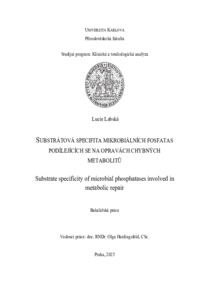Substrátová specifita mikrobiálních fosfatas podílejících se na opravách chybných metabolitů
Substrate specificity of microbial phosphatases involved in metabolic repair
bachelor thesis (DEFENDED)

View/
Permanent link
http://hdl.handle.net/20.500.11956/199131Identifiers
Study Information System: 276424
Collections
- Kvalifikační práce [20869]
Author
Advisor
Referee
Čermáková, Michaela
Faculty / Institute
Faculty of Science
Discipline
Clinical and Toxicological Analysis
Department
Department of Biochemistry
Date of defense
29. 5. 2025
Publisher
Univerzita Karlova, Přírodovědecká fakultaLanguage
Czech
Grade
Excellent
Keywords (Czech)
fosfatasa, glykolýza, 2-fosfoglykolát, Candida, MycobacteriumKeywords (English)
phosphatase, glycolysis, 2-phosphoglycolate, Candida, MycobacteriumHlavním cílem této práce bylo charakterizovat mikrobiální fosfatasy, které se podílejí na opravách chybných metabolitů vznikajících jako vedlejší produkty buněčného metabolismu. Jako zástupci enzymů z eukaryotických mikroorganismů byly vybrány fosfatasy z patogenních kvasinek Candida albicans a Candida parapsilosis. Doménu bakterií v této práci zastupuje Mycobacterium smegmatis, nepatogenní bakterie používaná jako bezpečný model pro studium patogenních mykobakterií. Z M. smegmatis byly vybrány tři necharakterizované geny, u kterých bylo možno předpokládat, že kódují fosfatasy. Metody byly založené na měření absorbance při 405 nm u produktu vznikajícího defosforylací para-nitrofenylfosfátu. U kvasinkových fosfatas z druhů C. albicans (CaPho15p) a C. parapsilosis (CpPho15p) byly otestovány různé druhy látek jako potenciální inhibitory. Nejvýznamnější inhibitory CpPho15p byly thiamin, pyridoxal hydrochlorid a glukosa-6-fosfát. U těchto látek bylo dále stanoveno i IC50, pomocí kterého byl thiamin určen jako nejlepší inhibitor. Žádná z testovaných látek neměla inhibiční vliv na CaPho15p. Různý vliv otestovaných látek na jednotlivé enzymy potvrzuje teorii, že mezi fosfatasami z obou kvasinek jsou podstatné rozdíly a je potřeba se více zabývat jejich substrátovou specifitou. U všech tří enzymů M....
The main goal of this thesis was to characterise microbial phosphatases involved in the repair of noncanonical metabolites formed as by-products of cellular metabolism. Phosphatases from the pathogenic yeasts Candida albicans and Candida parapsilosis were selected as the representatives of enzymes from eukaryotic microorganisms. The bacterial domain in this work is represented by Mycobacterium smegmatis, a non-pathogenic bacterium used as a safe model for the study of pathogenic mycobacteria. Three uncharacterized genes were selected from M. smegmatis, which are assumed to encode phosphatases. The methods used were based on measuring absorbance at 405 nm of the product formed by the dephosphorylation of para-nitrophenylphosphate. Various compounds were tested as potential inhibitors of the phosphatases from the pathogenic yeasts C. albicans (CaPho15p) and C. parapsilosis (CpPho15p). Significant inhibitors of CpPho15p included thiamine, pyridoxal hydrochloride and glucose-6-phosphate. The IC50 values were also determined for these compounds, with thiamine identified as the most effective inhibitor. None of the tested compounds inhibited CaPho15p. The different effects of the tested compounds on each of the enzymes confirm the theory that there are significant differences between them, highlighting...
